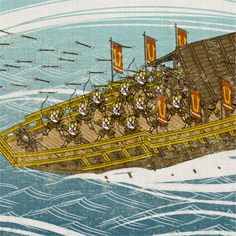
Basic Unit Statistics (can be modified by difficulty level, arts, skills, traits and retainers)
| Recruitment Cost | 2000 | |
| Upkeep Cost | 175 | |
| Marines | 80 | 66% |
| Seamen | 20 | 10% |
| Hull Strength | 400 | 4% |
| Morale | 18 | 36% |
Strengths & Weaknesses
- Large-sized, average speed vessel.
- Crew armed with bows and swords.
- Excellent morale.
- Excellent in ranged combat.
- Excellent in boarding battles.
Abilities
- Warcry - Warcry heavily demoralises up to seven nearby enemy units, slowing them down and affecting their defence ability for a short time.
- Whistling Arrows - Whistling arrows have an unsettling effect on both enemy and friendly crews, reducing their morale and combat ability for a short period when they fly over them.
Description
These large vessels are strong enough to take on any opponent, but perhaps not swift enough to catch some.
Samurai heavy ships carry large contingents of soldiers armed with bows and swords. This gives them excellent attacks both at range with arrows and in boarding actions. Against smaller ships, the samurai should have little trouble in sweeping all before them. The samurai also have high morale, thanks to their sense of personal honour: they are unlikely to back away from any fight. The only shortcoming is that their comparatively slow speed means that they can be outrun or outmanoeuvred. The samurai were not natural sea-warriors. Their strengths, traditions, habits and inclinations were all about combat on good, firm dry land. However, by playing to those strengths they were able to give good account of themselves in battle, as long as boarding actions were involved. In terms of seamanship, the samurai were not much help at sea. Manual labour was considered beneath consideration by the warrior classes, and sailing in medieval craft always required a lot of hard work.